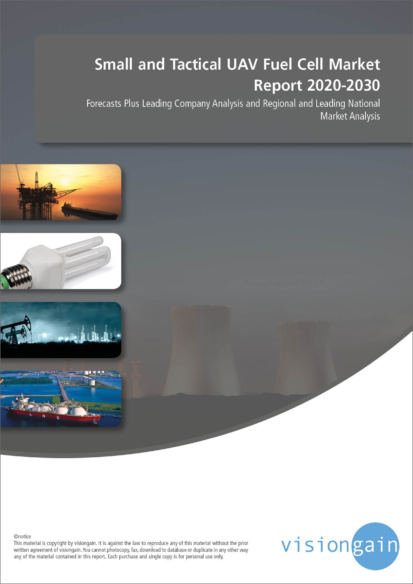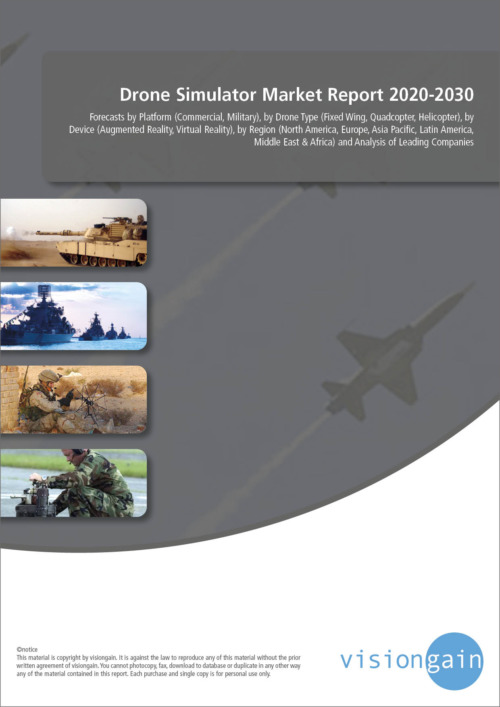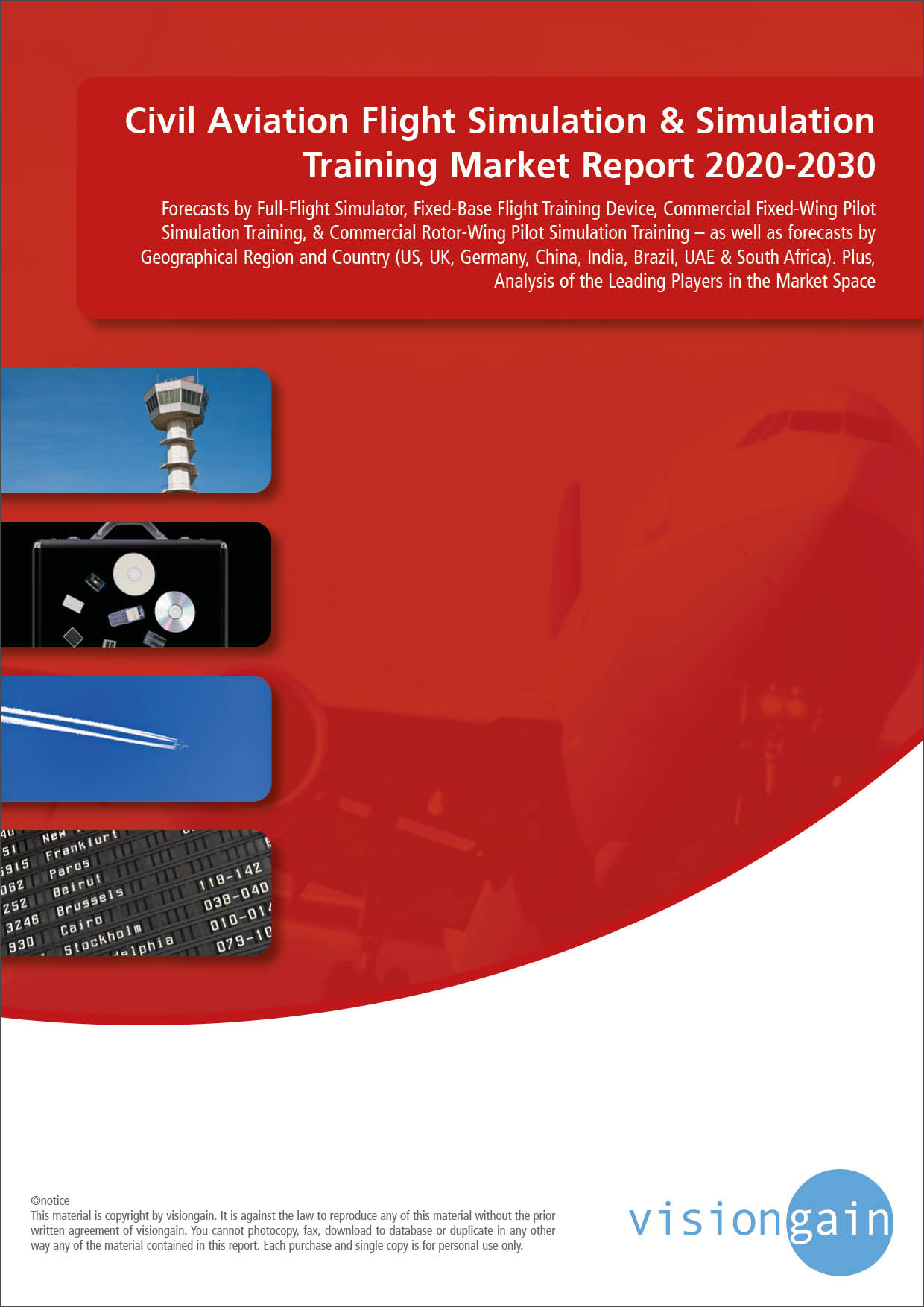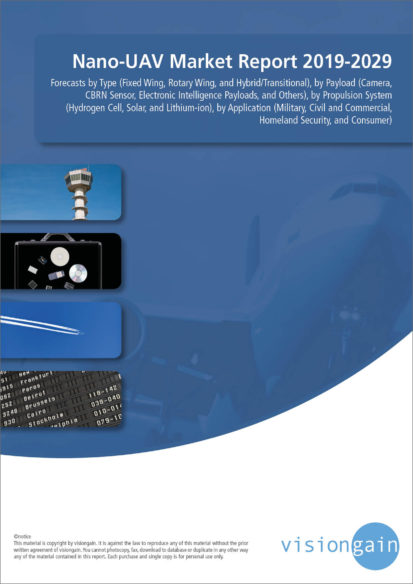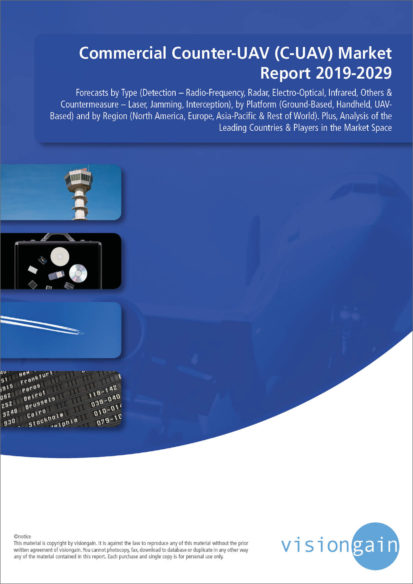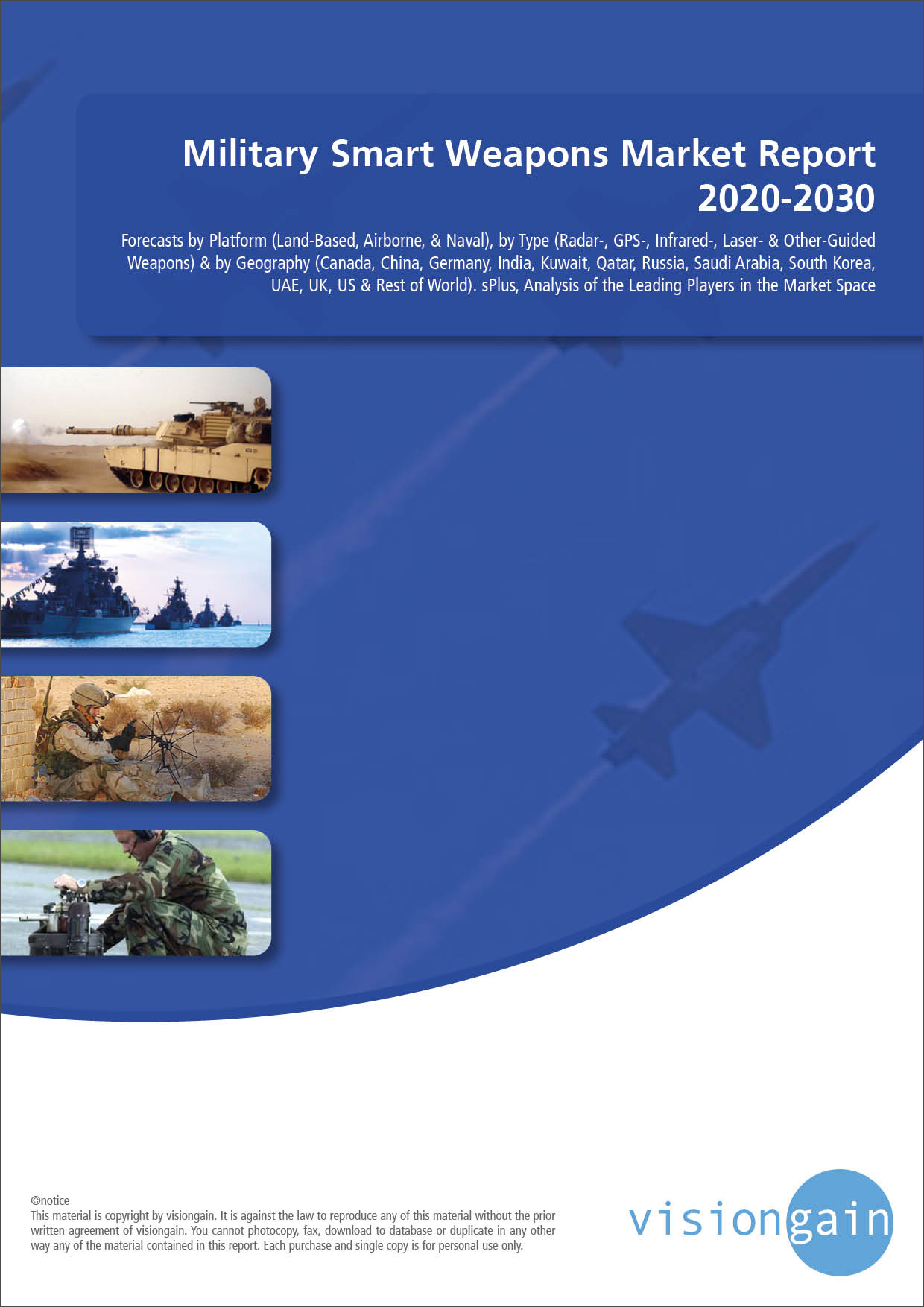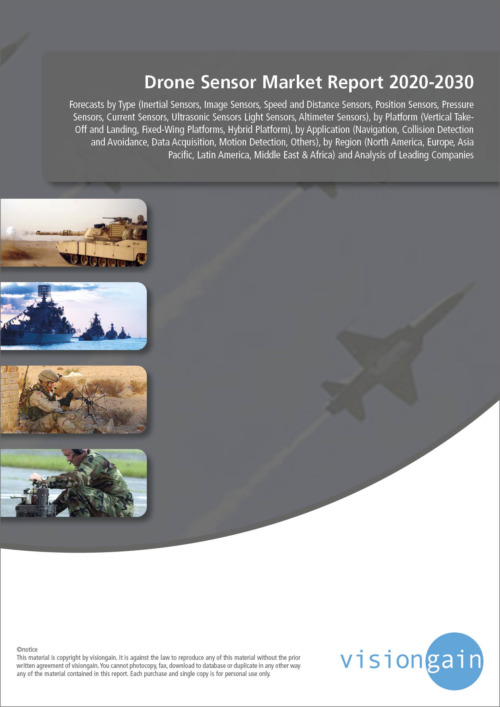This latest report by business intelligence provider Visiongain assesses that Small and Tactical UAV Fuel Cell Market is projected to grow at a CAGR of 14% during forecast period of 2020-2030. UAVs have evolved into increasingly capable platforms deployed for a wide variety of applications. The increasing demand and reliance on UAV in warfighting and peacekeeping operations has doubled the pace of UAV-related R&D in recent years. The ability to fight effectively in urban areas against widely-dispersed forces while minimizing collateral damage and achieving information superiority has enabled the UAVs to play a superior role in critical missions.
The commercial and military UAV manufacturers have been strategizing over the adoption of alternative propulsion technologies for UAVs. Lately, hydrogen fuel cells have emerged as a viable alternative fuel to replace Li-ion batteries in mid to large size drones. They offer compelling value for UAVs due to improved reliability over small internal combustion engines, enhancing safe and low maintenance operation. As the unique design features are facilitating alternative uses of UAVs, the development of newer generation engines will drive the small and tactical UAV fuel cell market growth during the forecast period.
It is therefore critical that you have your timescales correct and your forecasting plans ready. This report will ensure that you do. Visiongain’s report will ensure that you keep informed and ahead of your competitors. Gain that competitive advantage.
Increase in Investment from the Military Unmanned Aircraft Sectorecently UAVs are becoming one of the most significant weapons in the military’s arsenal. Simultaneously, the number of civil and commercial UAV applications also is growing. The defense of U.S. has brought about new technology requirements for next-generation UAVs. The rule makers in the U.S. Federal Aviation Administration (FAA) in Washington and other aviation authorities around the globe also are feeling pressure to permit at least limited non-military UAV operations in civilian airspace.
By the end of next decade, the UAV industry would be anticipated to be approximately USD 10 billion, combining manufacturing, sales, jobs, etc., in the U.S. During the next two years, the FAA to finally set privacy rules for small UAVs, responding to a lot more pressure from manufacturers and from state and local governments. By 2025, the UAV are expected to be much bigger , delivering pesticides for agriculture, packages for Amazon and others, which means going from a nascent market at present to a multi-billion dollar industry in a decade or less.
Despite the latest rise in greener propulsion technologies (electric, renewable, hybrid, inner gas motor fuel, etc.), standard internal combustion engines, usually supplied with fossil fuels, still drive the vast bulk of present UAV motors. Alternatively to standard propulsion, three primary kinds of propulsion technologies can be regarded in UAVs, alternate heat solutions: where distinct kinds of thermodynamic cycles, diesel, or motors can be used, such as gasoline-fuelled spark-ignition reciprocating motors. Electrical systems: where the power required is obtained through an electric motor and power is generated or stored in different ways hybrid systems: combining any of the systems listed above, even the same type e.g., a combination of fuel cell and battery or Regenerative Fuel Cell Systems, RFC, which combine fuel cell, battery, and photovoltaic cells.
Those relying on fuel cells are among the most exciting alternative propulsion technologies for UAVs. It is still a technology that is undeveloped but increasing, with space for weight, quantity and price decrease improvements. Fuel cells are electrochemical devices that turn straight into electrical energy the chemical energy stored in food. They do not generate greenhouse gases when supplied with hydrogen, the only products are water and heat, and the engine’s amount of noise production is small.
Water, as well as heat and small oxygen-containing combustion gases, is the fuel cell’s end product that may have other apps to offset for weight disadvantages (especially in big UAVs), such as water supply for other subsystems, deicing or inerting a fossil fuel reservoir. Unlike batteries, there is no need to recharge a fuel cell; it continues to operate while supplying gas and oxidizer from outside. The fuel cell itself consists of an anode in which fuel (usually hydrogen, ammonia, or methanol) is injected and a cathode in which an oxidant (usually air or oxygen) is introduced, separated by an electrolyte ionic conductor.
For most UAV apps, fuel cells generate small voltages and need to be integrated into a fuel cell pile to achieve the energy needed. Because fuel cells are flexible equipment by their essence, their energy can range from microwatts to megawatts, rendering them beneficial in a multitude of apps.
The primary benefits of fuel cells are small emissions, elevated effectiveness, modularity, reversibility (this asset is used in RFC Systems), variety of gas, variety of apps, small noise, and poor infrarot mark. Their disadvantages, however, include costs, sensitivity of the electrode catalyst to poisons, their laboratory state, and absence of accessibility of H2. In systems powered by reciprocating and jet engines, fuel only contributes to propulsion in 18–25% of its energy, while in fuel cell powered aircraft this efficiency is in the region of 44%
Read on to discover how you can exploit the future business opportunities emerging in this sector. Visiongain’s new study tells you and tells you NOW. The 180-pages report provides clear, detailed insight into the global Small and Tactical UAV Fuel Cell market. Discover the key drivers and challenges affecting the market.
By ordering and reading our brand-new report today, you stay better informed and ready to act.
Report Scope
The report delivers considerable added value by revealing:
57 tables, charts and graphs are analyzing and revealing the growth prospects and outlook for the Small and Tactical UAV Fuel Cell market.
Global Small and Tactical UAV Fuel Cell market forecasts and analysis from 2020-2030.
Small and Tactical UAV Fuel Cell market provides revenue estimates, forecasts and analysis from 2020-2030 for Small and Tactical UAV Fuel Cell submarkets:
Forecasts and analysis of Small and Tactical UAV Fuel Cell market by Type between 2020-2030
Hydrogen Fuel Cells Market, 2020-2030
Solid Oxide Fuel Cells (SOFC) Market, 2020-2030
Proton Exchange Membrane (PEM) Market, 2020-2030
Direct Methanol Fuel Cell (DMFC) Market, 2020-2030
Fuel Cells Others Market, 2020-2030
Forecasts and analysis of Small and Tactical UAV Fuel Cell market by Application between 2020-2030
Military Market, 2020-2030
Commercial and Civil Market, 2020-2030
Infrastructure Monitoring Market, 2020-2030
Agriculture Market, 2020-2030
Environmental Monitoring and Conservation Market, 2020-2030
Real Estate Market, 2020-2030
Delivery Market, 2020-2030
Wireless Internet Access Market, 2020-2030
Regional Small and Tactical UAV Fuel Cell market forecasts from 2020-2030 with drivers and restraints for the countries including:
Geographic Breakdown
Focused regional forecasts and analysis explore the future opportunities:
North America Market, 2020-2030
US Market, 2020-2030
Canada Market, 2020-2030
Europe Market, 2020-2030
The UK Market, 2020-2030
Germany Market, 2020-2030
France Market, 2020-2030
Italy Market, 2020-2030
Spain Market, 2020-2030
Rest of Europe Market, 2020-2030
Asia-Pacific Market, 2020-2030
China Market, 2020-2030
India Market, 2020-2030
Japan Market, 2020-2030
Australia & New Zealand Market, 2020-2030
Rest of Asia-Pacific Market, 2020-2030
LAMEA Market, 2020-2030
Latin America Market, 2020-2030
Middle East Market, 2020-2030
Africa Market, 2020-2030
Figure:- Small and Tactical UAV Fuel Cell Market Size and Forecast by Region, 2020-2030
Company profiles for the leading Small and Tactical UAV Fuel Cell companies
Company Profiles of Leading Players
Naval Research Lab
Adaptive Materials Inc.
Ballard Power Systems
FH Wiesbaden
Horizon Energy
Protonex
EnergyOr
DLR
UTRC
BCS
Horizon Fuel Cell Technologies
Other Key Players in the market
Power Innovations International Inc.
W.L. Gore & Associates
Nel Hydrogen
Johnson Matthey Fuel Cells
United Hydrogen Group
Doosan Mobility Innovation
Georgia Inst. of Tech.
HES Energy Systems
Intelligent Energy
MicroMultiCopter Aero Technology
Ultra Electronics
EnergyOR Technologies
UAV Manufacturers
AeroVironment
Elbit Systems
Israel Aerospace Corporation
Aeryon Labs Inc.,
Conclusions and recommendations which will aid decision-making
How will you benefit from this report?
Keep your knowledge base up to speed. Don’t get left behind
Reinforce your strategic decision-making with definitive and reliable market data
Learn how to exploit new technological trends
Realise your company’s full potential within the market
Understand the competitive landscape and identify potential new business opportunities & partnerships
Who should read this report?
Anyone with involvement in the Small and Tactical UAV Fuel Cell
Energy operators
Engineering contractors
Investment managers
Arbitrage companies and divisions
Fuel Cell price reporting companies
Fuel Cell company managers
Fuel Cell consultants
Fuel Cell company executives and analysts
Heads of strategic development
Business development managers
Marketing managers
Market analysts,
Technologists
Suppliers
Investors
Banks
Government agencies
Visiongain’s study is intended for anyone requiring commercial analyses for the Small and Tactical UAV Fuel Cell market and leading companies. You find data, trends and predictions.
Buy our report today the Small and Tactical UAV Fuel Cell Market Forecast 2020-2030. Avoid missing out by staying informed – get our report now.
Visiongain is a trading partner with the US Federal Government
CCR Ref number: KD4R6
Do you have any custom requirements we can help you with? Any need for specific country, geo region, market segment or specific company information? Contact us today, we can discuss your needs and see how we can help sara.peerun@visiongain.com
Report Overview
1.1 Global Small and Tactical UAV Fuel Cell Market
1.2 Global Small and Tactical UAV Fuel Cell Market Overview
1.3 Global Small and Tactical UAV Fuel Cell Market Segmentation
1.4 The Emergence of Small and Tactical UAV Fuel Cell in the Industry
1.5 Why You Should Read This Report
1.6 How This Report Delivers
1.7 Key Questions Answered by This Analytical Report
1.8 Methodology
1.8.1 Secondary Research
1.8.2 Market Evaluation & Forecasting Methodology
1.9 Frequently Asked Questions (FAQ)
1.10 Associated Visiongain Reports
1.11 About Visiongain
2. Introduction to Small and Tactical UAV Fuel Cell Market
2.1 Market Definition
2.2 Industry Outlook
2.3 Value Chain Analysis
2.4 Industry Structure
2.5 Current Status & Trends
2.6 Demand & Supply Analysis
2.7 Trade Analysis
2.8 Price Trend Analysis
2.9 Design variables and constraints
2.9.1 Electric Motor Scaling Parameter
2.9.2 Number of Propellers/Motors
2.9.3 Number of Fuel Cells
2.9.4 Fuel Cell Active Area
2.9.5 Hydrogen Tank Radius
2.9.6 Hydrogen Storage Pressure
2.9.7 Wing Aspect Ratio
2.9.8 Motor to Propeller Gear Ratio
3. Global Small and Tactical UAV Fuel Cell Market Analysis
3.1 PEST Analysis of the Small and Tactical UAV Fuel Cell Market
3.2 Expert Opinion
3.2.1 Primary Correspondents
3.3 Market Outlook
3.4 Drivers & Restraints
3.5 Dominant Region/Country
3.6 Market Scenario
3.7 Overall Growth Rate, Globally
3.8 SWOT Analysis of the Small and Tactical UAV Fuel Cell Market
3.8.1 Strengths
3.8.2 Weaknesses
3.8.3 Opportunities
3.8.4 Threats
3.9 Porter’s Five Forces Analysis
3.9.1 Competitive Rivalry
3.9.2 Supplier Power
3.9.3 Buyer Power
3.9.4 Threat of Substitute
3..9.5 Threat of New Entrant
4. Small and Tactical UAV Fuel Cell: Global Market Analysis by Segments
4.1 Global Small and Tactical UAV Fuel Cell Market Forecast, by Type 2020-2030
4.1.1 Type Overview
4.1.2 Hydrogen Fuel Cells Market, 2020-2030
4.1.3 Solid Oxide Fuel Cells (SOFC) Market, 2020-2030
4.1.4 Proton Exchange Membrane (PEM) Market, 2020-2030
4.1.5 Direct Methanol Fuel Cell (DMFC) Market, 2020-2030
4.1.6 Fuel Cells Others Market, 2020-2030
4.2 Global Small and Tactical UAV Fuel Cell Market Forecast, by Application 2020-2030
4.2.1 Application Overview
4.2.2 Military Market, 2020-2030
4.2.3 Commercial and Civil Market, 2020-2030
4.2.4 Infrastructure Monitoring Market, 2020-2030
4.2.5 Agriculture Market, 2020-2030
4.2.6 Environmental Monitoring and Conservation Market, 2020-2030
4.2.7 Real Estate Market, 2020-2030
4.2.8 Delivery Market, 2020-2030
4.2.9 Wireless Internet Access Market, 2020-2030
5. Leading Regions in Small and Tactical UAV Fuel Cell Market 2020-2030
5.1 Regional Overview
5.1.1 North America
5.1.2 Europe
5.1.3 Asia Pacific
5.1.4 LAMEA
5.1.5 Leading Countries/ Regions
5.2 U.S. Small and Tactical UAV Fuel Cell Market Forecast, 2020-2030
5.2.1 U.S. Small and Tactical UAV Fuel Cell Submarket, By Type Forecast 2020-2030
5.2.2 U.S. Small and Tactical UAV Fuel Cell Submarket, By Application Forecast 2020-2030
5.3 Canada Small and Tactical UAV Fuel Cell Market Forecast, 2020-2030
5.3.1 Canada Small and Tactical UAV Fuel Cell Submarket, By Type Forecast 2020-2030
5.3.2 Canada Small and Tactical UAV Fuel Cell Submarket, By Application Forecast 2020-2030
5.4 The UK Small and Tactical UAV Fuel Cell Market Forecast, 2020-2030
5.4.1 The UK Small and Tactical UAV Fuel Cell Submarket, By Type Forecast 2020-2030
5.4.2 The UK Small and Tactical UAV Fuel Cell Submarket, By Application Forecast 2020-2030
5.5 Germany Small and Tactical UAV Fuel Cell Market Forecast, 2020-2030
5.5.1 Germany Small and Tactical UAV Fuel Cell Submarket, By Type Forecast 2020-2030
5.5.2 Germany Small and Tactical UAV Fuel Cell Submarket, By Application Forecast 2020-2030
5.6 France Small and Tactical UAV Fuel Cell Market Forecast, 2020-2030
5.6.1 France Small and Tactical UAV Fuel Cell Submarket, By Type Forecast 2020-2030
5.6.2 France Small and Tactical UAV Fuel Cell Submarket, By Application Forecast 2020-2030
5.7 Italy Small and Tactical UAV Fuel Cell Market Forecast, 2020-2030
5.7.1 Italy Small and Tactical UAV Fuel Cell Submarket, By Type Forecast 2020-2030
5.7.2 Italy Small and Tactical UAV Fuel Cell Submarket, By Application Forecast 2020-2030
5.8 Spain Small and Tactical UAV Fuel Cell Market Forecast, 2020-2030
5.8.1 Spain Small and Tactical UAV Fuel Cell Submarket, By Type Forecast 2020-2030
5.8.2 Spain Small and Tactical UAV Fuel Cell Submarket, By Application Forecast 2020-2030
5.9 Rest of Europe Small and Tactical UAV Fuel Cell Market Forecast, 2020-2030
5.9.1 Rest of Europe Small and Tactical UAV Fuel Cell Submarket, By Type Forecast 2020-2030
5.9.2 Rest of Europe Small and Tactical UAV Fuel Cell Submarket, By Application Forecast 2020-2030
5.10 China Small and Tactical UAV Fuel Cell Market Forecast, 2020-2030
5.10.1 China Small and Tactical UAV Fuel Cell Submarket, By Type Forecast 2020-2030
5.10.2 China Small and Tactical UAV Fuel Cell Submarket, By Application Forecast 2020-2030
5.11 India Small and Tactical UAV Fuel Cell Market Forecast, 2020-2030
5.11.1 India Small and Tactical UAV Fuel Cell Submarket, By Type Forecast 2020-2030
5.11.2 India Small and Tactical UAV Fuel Cell Submarket, By Application Forecast 2020-2030
5.12 Japan Small and Tactical UAV Fuel Cell Market Forecast, 2020-2030
5.12.1 Japan Small and Tactical UAV Fuel Cell Submarket, By Type Forecast 2020-2030
5.12.2 Japan Small and Tactical UAV Fuel Cell Submarket, By Application Forecast 2020-2030
5.13 Australia & New Zealand Small and Tactical UAV Fuel Cell Market Forecast, 2020-2030
5.13.1 Australia & New Zealand Small and Tactical UAV Fuel Cell Submarket, By Type Forecast 2020-2030
5.13.2 Australia & New Zealand Small and Tactical UAV Fuel Cell Submarket, By Application Forecast 2020-2030
5.14 Rest of Asia-Pacific Small and Tactical UAV Fuel Cell Market Forecast, 2020-2030
5.14.1 Rest of Asia-Pacific Small and Tactical UAV Fuel Cell Submarket, By Type Forecast 2020-2030
5.14.2 Rest of Asia-Pacific Small and Tactical UAV Fuel Cell Submarket, By Application Forecast 2020-2030
5.15 Latin America Small and Tactical UAV Fuel Cell Market Forecast, 2020-2030
5.15.1 Latin America Small and Tactical UAV Fuel Cell Submarket, By Type Forecast 2020-2030
5.15.2 Latin America Small and Tactical UAV Fuel Cell Submarket, By Application Forecast 2020-2030
5.16 Middle East Small and Tactical UAV Fuel Cell Market Forecast, 2020-2030
5.16.1 Middle East Small and Tactical UAV Fuel Cell Submarket, By Type Forecast 2020-2030
5.16.2 Middle East Small and Tactical UAV Fuel Cell Submarket, By Application Forecast 2020-2030
5.17 Africa Small and Tactical UAV Fuel Cell Market Forecast, 2020-2030
5.17.1 Africa Small and Tactical UAV Fuel Cell Submarket, By Type Forecast 2020-2030
5.17.2 Africa Small and Tactical UAV Fuel Cell Submarket, By Application Forecast 2020-2030
7. Leading Companies in The Small and Tactical UAV Fuel Cell Market
7.1 Adaptive Materials Inc.
7.1.1 Adaptive Materials Inc. Products and Services
7.1.2 Analysis of Adaptive Materials Inc. within the Small and Tactical UAV Fuel Cell Market
7.1.3 Adaptive Materials Inc. M&A Activity
7.1.4 Future Outlook for Adaptive Materials Inc.
7.1.5 Adaptive Materials Inc. Projects
7.2 Horizon Energy
7.2.1 Horizon Energy Products and Services
7.2.2 Analysis of Horizon Energy within the Small and Tactical UAV Fuel Cell Market
7.2.3 Horizon Energy M&A Activity
7.2.4 Future Outlook for Horizon Energy
7.2.5 Horizon Energy Projects
7.3 Ballard Power Systems
7.3.1 Ballard Power Systems Products and Services
7.3.2 Analysis of Ballard Power Systems within the Small and Tactical UAV Fuel Cell Market
7.3.3 Ballard Power Systems M&A Activity
7.3.4 Future Outlook for Ballard Power Systems
7.3.5 Ballard Power Systems Projects
7.4 FH Wiesbaden
7.4.1 FH Wiesbaden Products and Services
7.4.2 Analysis of FH Wiesbaden within the Small and Tactical UAV Fuel Cell Market
7.4.3 FH Wiesbaden M&A Activity
7.4.4 Future Outlook for FH Wiesbaden
7.4.5 FH Wiesbaden Projects
7.5 Naval Research Lab
7.5.1 Naval Research Lab Products and Services
7.5.2 Analysis of Naval Research Lab within the Small and Tactical UAV Fuel Cell Market
7.5.3 Naval Research Lab M&A Activity
7.5.4 Future Outlook for Naval Research Lab
7.5.5 Naval Research Lab Projects
7.6 Protonex
7.6.1 Protonex Products and Services
7.6.2 Analysis of Protonex within the Small and Tactical UAV Fuel Cell Market
7.6.3 Protonex M&A Activity
7.6.4 Future Outlook for Protonex
7.6.5 Protonex Projects
7.7 EnergyOr
7.7.1 EnergyOr Products and Services
7.7.2 Analysis of EnergyOr within the Small and Tactical UAV Fuel Cell Market
7.7.3 EnergyOr M&A Activity
7.7.4 Future Outlook for EnergyOr
7.7.5 EnergyOr Projects
7.8 DLR
7.8.1 DLR Products and Services
7.8.2 Analysis of DLR within the Small and Tactical UAV Fuel Cell Market
7.8.3 DLR M&A Activity
7.8.4 Future Outlook for DLR
7.8.5 DLR Projects
7.9 UTRC
7.9.1 UTRC Products and Services
7.9.2 Analysis of UTRC within the Small and Tactical UAV Fuel Cell Market
7.9.3 UTRC M&A Activity
7.9.4 Future Outlook for UTRC
7.9.5 UTRC Projects
7.10 BCS
7.10.1 BCS Products and Services
7.10.2 Analysis of BCS within the Small and Tactical UAV Fuel Cell Market
7.10.3 BCS M&A Activity
7.10.4 Future Outlook for BCS
7.10.5 BCS Projects
7.11 Horizon Fuel Cell Technologies
7.11.1 Horizon Fuel Cell Technologies Products and Services
7.11.2 Analysis of Horizon Fuel Cell Technologies within the Small and Tactical UAV Fuel Cell Market
7.11.3 Horizon Fuel Cell Technologies M&A Activity
7.11.4 Future Outlook for Horizon Fuel Cell Technologies
7.11.5 Horizon Fuel Cell Technologies Projects
8. Conclusions and Recommendations
8.1 Global Small and Tactical UAV Fuel Cell Market Outlook
8.2 Recommendations
9. Glossary
Associated Visiongain Reports
Visiongain Report Sales Order Form
Appendix A
About Visiongain
Appendix B
Visiongain Report Evaluation Form
List of Tables
Table 1.0 Key Highlights
Table 3.1 PEST Analysis, Small and Tactical UAV Fuel Cell Market
Table 3.2 SWOT Analysis
Table 4.1 Global Small and Tactical UAV Fuel Cell Market Forecast 2020-2030 ($Bn, AGR %, CAGR %, Cumulative)
Table 4.2 Global Small and Tactical UAV Fuel Cell Submarket, By Type Forecast 2020-2030 ($billion, AGR %, Cumulative)
Table 4.3 Global Small and Tactical UAV Fuel Cell Submarket, By Forecast 2020-2030 ($billion, AGR %, Cumulative)
Table 4.4 Global Small and Tactical UAV Fuel Cell Submarket, By Forecast 2020-2030 ($billion, AGR %, Cumulative)
Table 5.1 Global Small and Tactical UAV Fuel Cell Market, by Country/Region Forecast 2020-2030 ($billion, AGR %, Cumulative)
Table 5.2 Global Small and Tactical UAV Fuel Cell Market, by Country/Region Forecast 2020-2030 ($billion, AGR %, Cumulative)
Table 5.3 Canada Small and Tactical UAV Fuel Cell Market Forecast 2020-2030 ($billion, , AGR %, CAGR %, Cumulative)
Table 5.4 Canada Small and Tactical UAV Fuel Cell Submarket, By Type Forecast 2020-2030 ($billion, AGR %, Cumulative)
Table 5.5 Canada Small and Tactical UAV Fuel Cell Submarket, By Application Forecast 2020-2030 ($billion, AGR %, Cumulative)
Table 5.6 US Small and Tactical UAV Fuel Cell Market Submarket, By Forecast 2020-2030 ($billion, , AGR %, CAGR %, Cumulative)
Table 5.7 US Small and Tactical UAV Fuel Cell Submarket, By Type Forecast 2020-2030 ($billion, AGR %, Cumulative)
Table 5.8 US Small and Tactical UAV Fuel Cell Submarket, By Application Forecast 2020-2030 ($billion, AGR %, Cumulative)
Table 5.9 Latin America Small and Tactical UAV Fuel Cell Market Forecast 2020-2030 ($billion, , AGR %, CAGR %, Cumulative)
Table 5.10 Latin America Small and Tactical UAV Fuel Cell Submarket, By Type Forecast 2020-2030 ($billion, AGR %, Cumulative)
Table 5.11 Latin America Small and Tactical UAV Fuel Cell Submarket, By Application Forecast 2020-2030 ($billion, AGR %, Cumulative)
Table 5.12 Germany Small and Tactical UAV Fuel Cell Market Submarket, By Forecast 2020-2030 ($billion, , AGR %, CAGR %, Cumulative)
Table 5.13 Germany Small and Tactical UAV Fuel Cell Submarket, By Type Forecast 2020-2030 ($billion, AGR %, Cumulative)
Table 5.14 Germany Small and Tactical UAV Fuel Cell Submarket, By Application Forecast 2020-2030 ($billion, AGR %, Cumulative)
Table 5.15 UK Small and Tactical UAV Fuel Cell Market Submarket, By Forecast 2020-2030 ($billion, , AGR %, CAGR %, Cumulative)
Table 5.16 UK Small and Tactical UAV Fuel Cell Submarket, By Type Forecast 2020-2030 ($billion, AGR %, Cumulative)
Table 5.17 UK Small and Tactical UAV Fuel Cell Submarket, By Application Forecast 2020-2030 ($billion, AGR %, Cumulative)
Table 5.18 Spain Small and Tactical UAV Fuel Cell Market Submarket, By Forecast 2020-2030 ($billion, , AGR %, CAGR %, Cumulative)
Table 5.19 Spain Small and Tactical UAV Fuel Cell Submarket, By Type Forecast 2020-2030 ($billion, AGR %, Cumulative)
Table 5.20 Spain Small and Tactical UAV Fuel Cell Submarket, By Application Forecast 2020-2030 ($billion, AGR %, Cumulative)
Table 5.21 UK Small and Tactical UAV Fuel Cell Submarket, By Forecast 2020-2030 ($billion, , AGR %, CAGR %, Cumulative)
Table 5.22 UK Small and Tactical UAV Fuel Cell Submarket, By Type Forecast 2020-2030 ($billion, AGR %, Cumulative)
Table 5.23 UK Small and Tactical UAV Fuel Cell Submarket, By Application Forecast 2020-2030 ($billion, AGR %, Cumulative)
Table 5.24 China Small and Tactical UAV Fuel Cell Submarket, By Forecast 2020-2030 ($billion, , AGR %, CAGR %, Cumulative)
Table 5.25 China Small and Tactical UAV Fuel Cell Submarket, By Type Forecast 2020-2030 ($billion, AGR %, Cumulative)
Table 5.26 China Small and Tactical UAV Fuel Cell Submarket, By Application Forecast 2020-2030 ($billion, AGR %, Cumulative)
Table 5.27 Australia Small and Tactical UAV Fuel Cell Submarket, By Forecast 2020-2030 ($billion, , AGR %, CAGR %, Cumulative)
Table 5.28 Australia Small and Tactical UAV Fuel Cell Submarket, By Type Forecast 2020-2030 ($billion, AGR %, Cumulative)
Table 5.29 Australia Small and Tactical UAV Fuel Cell Submarket, By Application Forecast 2020-2030 ($billion, AGR %, Cumulative)
Table 5.30 South Korea Small and Tactical UAV Fuel Cell Submarket, By Forecast 2020-2030 ($billion, , AGR %, CAGR %, Cumulative)
Table 5.31 South Korea Small and Tactical UAV Fuel Cell Submarket, By Type Forecast 2020-2030 ($billion, AGR %, Cumulative)
Table 5.32 South Korea Small and Tactical UAV Fuel Cell Submarket, By Application Forecast 2020-2030 ($billion, AGR %, Cumulative)
Table 5.33 Japan Small and Tactical UAV Fuel Cell Submarket, By Forecast 2020-2030 ($billion, , AGR %, CAGR %, Cumulative)
Table 5.34 Japan Small and Tactical UAV Fuel Cell Submarket, By Type Forecast 2020-2030 ($billion, AGR %, Cumulative)
Table 5.35 Japan Small and Tactical UAV Fuel Cell Submarket, By Application Forecast 2020-2030 ($billion, AGR %, Cumulative)
Table 5.36 India Small and Tactical UAV Fuel Cell Submarket, By Forecast 2020-2030 ($billion, , AGR %, CAGR %, Cumulative)
Table 5.37 India Small and Tactical UAV Fuel Cell Submarket, By Type Forecast 2020-2030 ($billion, AGR %, Cumulative)
Table 5.38 India Small and Tactical UAV Fuel Cell Submarket, By Application Forecast 2020-2030 ($billion, AGR %, Cumulative)
Table 5.39 Middle East Small and Tactical UAV Fuel Cell Submarket, By Forecast 2020-2030 ($billion, , AGR %, CAGR %, Cumulative)
Table 5.40 Middle East Small and Tactical UAV Fuel Cell Submarket, By Type Forecast 2020-2030 ($billion, AGR %, Cumulative)
Table 5.41 Middle East Small and Tactical UAV Fuel Cell Submarket, By Application Forecast 2020-2030 ($billion, AGR %, Cumulative)
Table 5.42 Rest of Asia-Pacific Small and Tactical UAV Fuel Cell Submarket, By Forecast 2020-2030 ($billion , , AGR %, CAGR %, Cumulative)
Table 5.43 Rest of Asia-Pacific Small and Tactical UAV Fuel Cell Submarket, By Type Forecast 2020-2030 ($billion , AGR %, Cumulative)
Table 5.44 Rest of Asia-Pacific Small and Tactical UAV Fuel Cell Submarket, By Application Forecast 2020-2030 ($billion , AGR %, Cumulative)
Table 5.45 Rest of Europe Small and Tactical UAV Fuel Cell Submarket, By Forecast 2020-2030 ($billion, , AGR %, CAGR %, Cumulative)
Table 5.46 Rest of Europe Small and Tactical UAV Fuel Cell Submarket, By Type Forecast 2020-2030 ($billion, AGR %, Cumulative)
Table 5.47 Rest of Europe Small and Tactical UAV Fuel Cell Submarket, By Application Forecast 2020-2030 ($billion, AGR %, Cumulative)
Table 5.48 Africa Small and Tactical UAV Fuel Cell Submarket, By Forecast 2020-2030 ($billion, , AGR %, CAGR %, Cumulative)
Table 5.49 Africa Small and Tactical UAV Fuel Cell Submarket, By Type Forecast 2020-2030 ($billion, AGR %, Cumulative)
Table 5.50 Africa Small and Tactical UAV Fuel Cell Submarket, By Application Forecast 2020-2030 ($billion, AGR %, Cumulative)
Table 5.51 Spain Small and Tactical UAV Fuel Cell Submarket, By Forecast 2020-2030 ($billion , , AGR %, CAGR %, Cumulative)
Table 5.52 Spain Small and Tactical UAV Fuel Cell Submarket, By Type Forecast 2020-2030 ($billion , AGR %, Cumulative)
Table 5.53 Spain Small and Tactical UAV Fuel Cell Submarket, By Application Forecast 2020-2030 ($billion , AGR %, Cumulative)
Table 7.1 Adaptive Materials Inc. Profile 2019 (Market Entry, Public/Private, Headquarters, Geography, Key Market, Listed on, Products/Services
Table 7.2 Adaptive Materials Inc. Profile 2019 (Market Entry, Public/Private, Headquarter, Total Company Revenue $billion, Change in Revenue, Geography, Key Market, Listed on, Products/Services)
Table 7.3 Adaptive Materials Inc. Products and Services (Product/Service, Notes)
Table 7.4 Adaptive Materials Inc. Total Company Sales 2015-2019 (US$billion, AGR %)
Table 7.5 Adaptive Materials Inc. Total Company Recent Development 2015-2019
Table 7.6 Horizon Energy Profile 2019 (Market Entry, Public/Private, Headquarter, Total Company Revenue $billion, Change in Revenue, Geography, Key Market, Listed on, Products/Services)
Table 7.7 Horizon Energy Products and Services (Product/Service, Notes)
Table 7.8 Horizon Energy Total Company Sales 2015-2019 (US$billion, AGR %)
Table 7.9 Horizon Energy Total Company Recent Development 2015-2019
Table 7.10 Ballard Power Systems Profile 2019 (Market Entry, Public/Private, Headquarter, Total Company Revenue $billion, Change in Revenue, Geography, Key Market, Listed on, Products/Services)
Table 7.11 Ballard Power Systems Products and Services (Product/Service, Notes)
Table 7.12 Ballard Power Systems Total Company Sales 2015-2019 (US$billion, AGR %)
Table 7.13 Ballard Power Systems Total Company Recent Development 2015-2019
Table 7.14 FH Wiesbaden Profile 2019 (Market Entry, Public/Private, Headquarter, Total Company Revenue $billion, Change in Revenue, Geography, Key Market, Listed on, Products/Services)
Table 7.15 FH Wiesbaden Products and Services (Product/Service, Notes)
Table 7.16 FH Wiesbaden Total Company Sales 2015-2019 (US$billion, AGR %)
Table 7.17 FH Wiesbaden Total Company Recent Development 2015-2019
Table 7.18 Naval Research Lab Profile 2019 (Market Entry, Public/Private, Headquarter, Total Company Revenue $billion, Change in Revenue, Geography, Key Market, Listed on, Products/Services)
Table 7.19 Naval Research Lab Products and Services (Product/Service, Notes)
Table 7.20 Naval Research Lab Total Company Sales 2015-2019 (US$billion, AGR %)
Table 7.21 Naval Research Lab Total Company Recent Development 2015-2019
Table 7.22 Protonex Profile 2019 (Market Entry, Public/Private, Headquarter, Total Company Revenue $billion, Change in Revenue, Geography, Key Market, Listed on, Products/Services)
Table 7.23 Protonex Products and Services (Product/Service, Notes)
Table 7.24 Protonex Total Company Sales 2015-2019 (US$billion, AGR %)
Table 7.25 Protonex Total Company Recent Development 2015-2019
Table 7.26 EnergyOr Profile 2019 (Market Entry, Public/Private, Headquarter, Total Company Revenue $billion, Change in Revenue, Geography, Key Market, Listed on, Products/Services)
Table 7.27 EnergyOr Products and Services (Product/Service, Notes)
Table 7.28 EnergyOr Total Company Sales 2015-2019 (US$billion, AGR %)
Table 7.29 EnergyOr Total Company Recent Development 2015-2019
Table 7.30 DLR Profile 2019 (Market Entry, Public/Private, Headquarter, Total Company Revenue $billion, Change in Revenue, Geography, Key Market, Listed on, Products/Services)
Table 7.31 DLR Products and Services (Product/Service, Notes)
Table 7.32 DLR Total Company Sales 2015-2019 (US$billion, AGR %)
Table 7.33 DLR Total Company Recent Development 2015-2019
Table 7.34 UTRC Profile 2019 (Market Entry, Public/Private, Headquarter, Total Company Revenue $billion, Change in Revenue, Geography, Key Market, Listed on, Products/Services)
Table 7.35 UTRC Products and Services (Product/Service, Notes)
Table 7.36 UTRC Total Company Sales 2015-2019 (US$billion, AGR %)
Table 7.37 UTRC Total Company Recent Development 2015-2019
Table 7.38 BCS Profile 2019 (Market Entry, Public/Private, Headquarter, Total Company Revenue $billion, Change in Revenue, Geography, Key Market, Listed on, Products/Services)
Table 7.39 BCS Products and Services (Product/Service, Notes)
Table 7.40 BCS Total Company Sales 2015-2019 (US$billion, AGR %)
Table 7.41 BCS Total Company Recent Development 2015-2019
Table 7.42 Horizon Fuel Cell Technologies Profile 2019 (Market Entry, Public/Private, Headquarter, Total Company Revenue $billion, Change in Revenue, Geography, Key Market, Listed on, Products/Services)
Table 7.43 Horizon Fuel Cell Technologies Products and Services (Product/Service, Notes)
Table 7.44 Horizon Fuel Cell Technologies Total Company Sales 2015-2019 (US$billion, AGR %)
Table 7.45 Horizon Fuel Cell Technologies Total Company Recent Development 2015-2019
List of Figures
Figure 1.1 Global Small and Tactical UAV Fuel Cell Market Segmentation
Figure 2.1 Small and Tactical UAV Fuel Cell Value Chain Analysis
Figure 3.1 Small and Tactical UAV Fuel Cell Supply-Demand Analysis
Figure 4.1 Global Small and Tactical UAV Fuel Cell Forecast 2020-2030 ($billion, AGR %)
Figure 4.2 Global Small and Tactical UAV Fuel Cell Market Forecast 2020-2030
Figure 4.3 Global Small and Tactical UAV Fuel Cell Submarket Forecast by 2020-2030 ($ billion)
Figure 4.4 Global Small and Tactical UAV Fuel Cell Market By Type Share Forecast 2020, 2025, 2030 (% Share)
Figure 4.19 Global Small and Tactical UAV Fuel Cell by Submarket By Type Forecast 2020-2030 ($ million)
Figure 4.20 Global Small and Tactical UAV Fuel Cell Market, by Share Forecast 2020, 2025, 2030 (% Share)
Figure 4.21 Small and Tactical UAV Fuel Cell Market, By Type Forecast 2020-2030 ($billion, AGR%)
Figure 4.23 Small and Tactical UAV Fuel Cell Market, By Type Forecast 2020-2030 ($billion, AGR%)
Figure 4.25 Small and Tactical UAV Fuel Cell Market, By Type Forecast 2020-2030 ($billion, AGR%)
Figure 4.27 Small and Tactical UAV Fuel Cell Market, By Type Forecast 2020-2030 ($billion, AGR%)
Figure 5.1 Regional/Country Small and Tactical UAV Fuel Cell Market, by 2020-2030
Figure 5.3 Leading Country/Regional Small and Tactical UAV Fuel Cell Market Share, by 2020
Figure 5.4 Leading Country/Regional Small and Tactical UAV Fuel Cell Market Share, by 2025
Figure 5.5 Leading Country/Regional Small and Tactical UAV Fuel Cell Market Share, by 2030
Figure 5.6 Canada Small and Tactical UAV Fuel Cell Market Forecast 2020-2030 ($billion, AGR%)
Figure 5.7 Canada Small and Tactical UAV Fuel Cell Market, by Forecast 2020-2030
Figure 5.8 Canada Small and Tactical UAV Fuel Cell Submarket, By Type Forecast 2020-2030
Figure 5.9 Canada Small and Tactical UAV Fuel Cell Submarket , By Application Forecast 2020-2030
Figure 5.10 Canada Small and Tactical UAV Fuel Cell Submarket , By 2020-2030 ($billion, AGR%)
Figure 5.10 U.S. Small and Tactical UAV Fuel Cell Market Forecast 2020-2030 ($billion, AGR%)
Figure 5.11 U.S. Small and Tactical UAV Fuel Cell Market, by Forecast 2020-2030
Figure 5.12 U.S. Small and Tactical UAV Fuel Cell Submarket, By Type Forecast 2020-2030
Figure 5.13 U.S. Small and Tactical UAV Fuel Cell Submarket , By Application Forecast 2020-2030
Figure 5.13 U.S. Small and Tactical UAV Fuel Cell Submarket , By Forecast 2020-2030
Figure 5.14 Latin America Small and Tactical UAV Fuel Cell Market Forecast 2020-2030 ($billion , AGR%)
Figure 5.15 Latin America Small and Tactical UAV Fuel Cell Market, by Forecast 2020-2030
Figure 5.16 Latin America Small and Tactical UAV Fuel Cell Submarket, By Type Forecast 2020-2030
Figure 5.17 Latin America Small and Tactical UAV Fuel Cell Submarket , By Application Forecast 2020-2030
Figure 5.17 Latin America Small and Tactical UAV Fuel Cell Submarket , By Forecast 2020-2030
Figure 5.18 Germany Small and Tactical UAV Fuel Cell Market Forecast 2020-2030 ($billion, AGR%)
Figure 5.19 Germany Small and Tactical UAV Fuel Cell Market, by Forecast 2020-2030
Figure 5.20 Germany Small and Tactical UAV Fuel Cell Submarket, By Type Forecast 2020-2030
Figure 5.21 Germany Small and Tactical UAV Fuel Cell Submarket , By Application Forecast 2020-2030
Figure 5.21 Germany Small and Tactical UAV Fuel Cell Submarket , By Forecast 2020-2030
Figure 5.22 U.K. Small and Tactical UAV Fuel Cell Market Forecast 2020-2030 ($billion, AGR%)
Figure 5.23 U.K. Small and Tactical UAV Fuel Cell Market, by Forecast 2020-2030
Figure 5.24 U.K. Small and Tactical UAV Fuel Cell Submarket, By Type Forecast 2020-2030
Figure 5.25 U.K. Small and Tactical UAV Fuel Cell Submarket , By Application Forecast 2020-2030
Figure 5.25 U.K. Small and Tactical UAV Fuel Cell Submarket , By Forecast 2020-2030
Figure 5.26 Spain Small and Tactical UAV Fuel Cell Market Forecast 2020-2030 ($billion, AGR%)
Figure 5.27 Spain Small and Tactical UAV Fuel Cell Market, by Forecast 2020-2030
Figure 5.28 Spain Small and Tactical UAV Fuel Cell Submarket, By Type Forecast 2020-2030
Figure 5.29 Spain Small and Tactical UAV Fuel Cell Submarket , By Application Forecast 2020-2030
Figure 5.30 UK Small and Tactical UAV Fuel Cell Market Forecast 2020-2030 ($billion, AGR%)
Figure 5.31 UK Small and Tactical UAV Fuel Cell Market, by Forecast 2020-2030
Figure 5.32 UK Small and Tactical UAV Fuel Cell Submarket, By Type Forecast 2020-2030
Figure 5.33 UK Small and Tactical UAV Fuel Cell Submarket , By Application Forecast 2020-2030
Figure 5.34 China Small and Tactical UAV Fuel Cell Market Forecast 2020-2030 ($billion, AGR%)
Figure 5.35 China Small and Tactical UAV Fuel Cell Submarket , By , by Forecast 2020-2030
Figure 5.36 China Small and Tactical UAV Fuel Cell Submarket, By Type Forecast 2020-2030
Figure 5.37 China Small and Tactical UAV Fuel Cell Submarket , By Application Forecast 2020-2030
Figure 5.38 Australia Small and Tactical UAV Fuel Cell Market Forecast 2020-2030 ($billion, AGR%)
Figure 5.39 Australia Small and Tactical UAV Fuel Cell Submarket , By , by Forecast 2020-2030
Figure 5.40 Australia Small and Tactical UAV Fuel Cell Submarket, By Type Forecast 2020-2030
Figure 5.41 Australia Small and Tactical UAV Fuel Cell Submarket , By Application Forecast 2020-2030
Figure 5.42 South Korea Small and Tactical UAV Fuel Cell Market Forecast 2020-2030 ($billion, AGR%)
Figure 5.43 South Korea Small and Tactical UAV Fuel Cell Submarket , By , by Forecast 2020-2030
Figure 5.44 South Korea Small and Tactical UAV Fuel Cell Submarket, By Type Forecast 2020-2030
Figure 5.45 South Korea Small and Tactical UAV Fuel Cell Submarket , By Application Forecast 2020-2030
Figure 5.46 Japan Small and Tactical UAV Fuel Cell Market Forecast 2020-2030 ($billion, AGR%)
Figure 5.47 Japan Small and Tactical UAV Fuel Cell Submarket , By , by Forecast 2020-2030
Figure 5.48 Japan Small and Tactical UAV Fuel Cell Submarket, By Type Forecast 2020-2030
Figure 5.49 Japan Small and Tactical UAV Fuel Cell Submarket , By Application Forecast 2020-2030
Figure 5.50 India Small and Tactical UAV Fuel Cell Market Forecast 2020-2030 ($billion, AGR%)
Figure 5.51 India Small and Tactical UAV Fuel Cell Submarket , By , by Forecast 2020-2030
Figure 5.52 India Small and Tactical UAV Fuel Cell Submarket, By Type Forecast 2020-2030
Figure 5.53 India Small and Tactical UAV Fuel Cell Submarket , By Application Forecast 2020-2030
Figure 5.54 Middle East Small and Tactical UAV Fuel Cell Market Forecast 2020-2030 ($billion, AGR%)
Figure 5.55 Middle East Small and Tactical UAV Fuel Cell Submarket , By , by Forecast 2020-2030
Figure 5.56 Middle East Small and Tactical UAV Fuel Cell Submarket, By Type Forecast 2020-2030
Figure 5.57 Middle East Small and Tactical UAV Fuel Cell Submarket , By Application Forecast 2020-2030
Figure 5.70 Rest of the World Small and Tactical UAV Fuel Cell Market Forecast 2020-2030 ($billion , AGR%)
Figure 5.71 Rest of the World Small and Tactical UAV Fuel Cell Submarket , By , by Forecast 2020-2030
Figure 5.72 Rest of the World Small and Tactical UAV Fuel Cell Submarket, By Type Forecast 2020-2030
Figure 5.73 Rest of the World Small and Tactical UAV Fuel Cell Submarket , By Application Forecast 2020-2030
Figure 7.1 Adaptive Materials Inc. Total Company Sales 2013-2019 (US$ million, AGR %)
Figure 7.2 Horizon Energy Total Company Sales 2013-2019 (US$ million, AGR %)
Figure 7.3 Ballard Power Systems Total Company Sales 2013-2019 (US$ Bn, AGR %)
Figure 7.6 FH Wiesbaden Company Sales 2013-2019 (US$ bn, AGR %)
Figure 7.7 FH Wiesbaden Revenue % Share, by Segment, 2019
Figure 7.8 FH Wiesbaden Revenue % Share, by Geographical Trade, 2019
Figure 7.9 FH Wiesbaden Revenue % Share, by Business Segment, 2019
Figure 7.10 Naval Research Lab Revenue % Share, by Geographic Segment, 2019
Figure 7.11 Protonex Company Total Company Sales 2013-2019 (US$ million, AGR %)
Figure 7.12 EnergyOr Total Company Sales 2013-2019 (US$ million, AGR %)
Figure 7.13 EnergyOr Revenue % Share, by Regional Segment, 2019
Figure 7.14 DLR Total Company Sales 2013-2019 (US$ million, AGR %)
Figure 7.15 DLR Revenue % Share, by Regional Segment, 2019
Figure 7.16 DLR Revenue % Share, by Business Segment, 2019
Figure 7.17 UTRC Total Company Sales 2013-2019 (US$ bn, AGR %)
Figure 7.18 BCS Total Company Revenue 2013-2019 (US$ bn, AGR %)
Figure 7.19 BCS Company Sales 2014-2019 (US$ bn, AGR %)
Figure 7.20 BCS Revenue % Share, by Business Segment, 2019
